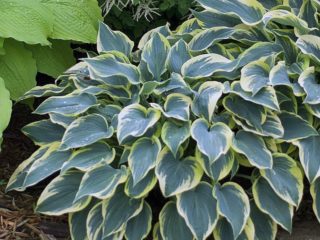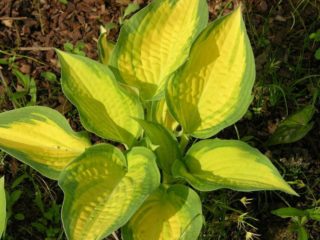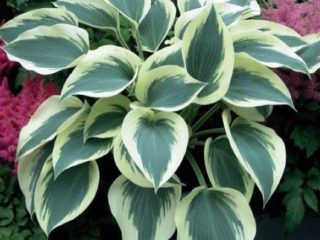Content
- 1 The need to transplant the hosta to another location
- 2 When can hosta be replanted?
- 3 How to replant a hosta correctly
- 4 Caring for flowers after transplantation
- 5 Recommendations from flower growers
- 6 Conclusion
It is recommended to replant the hosta on the site to a new place every 5-6 years. First of all, this should be done in order to rejuvenate the flower and prevent it from becoming too thick. In addition, dividing the bush is the most popular and easiest way to propagate hostas. This procedure is not complicated, but it is important to know when and how to do it. Having familiarized yourself with the peculiarities of transplanting hostas depending on the season of the year and the climatic conditions of the region, you can determine when it is best to do this on your own site.Transplantation carried out according to all the rules will help the plant to remain healthy for a long time and maintain a beautiful decorative appearance, actively growing and developing.
The need to transplant the hosta to another location
Hosta, also known as funkia, is an ornamental herbaceous plant brought to Europe from Japan in the 18th century. Today this unpretentious, frost-resistant and shade-loving perennial widely used in landscape design. Its large, wide leaves of different colors and shapes form lush, expressive bushes that can fit into almost any composition.
In fact, a hosta can exist in one place for up to 15-20 years. However, it is still recommended to replant this flower from time to time.

A hosta bush can live in one place for up to 20 years, but it is advisable to replant it every 5-6 years
Why you need to do this:
- Over the course of 4-5 years, the root system of the hosta manages to extract a large amount of microelements and nutrients from the soil. As a result, the soil becomes poorer, growth rates slow down, leaves become smaller and lose shape, and flowering becomes poor.
- Young shoots appear on the bush every year. As a rule, by 5-6 years it grows greatly and becomes too thick. Dividing the bush and planting its parts helps solve this problem.
- Sometimes you can transplant the hosta to another place, into fresh and fertile soil in order to “reanimate” it. This measure can help save a flower that has been severely damaged by disease or exposure to harmful insects.
Hosta transplantation is best done once every 4-6 years, depending on its type.This procedure can damage a flower that is too young: it will take a long time to adapt to a new place, while stopping its development for a year or two. An overly old plant has very massive and overgrown roots, which will be difficult to carefully dig out of the ground when replanting without disturbing their integrity.
It happens that a young hosta bush cannot get used to a new place for a long time. If its leaves turn yellow, wither and begin to fall off, the color fades, and young shoots do not appear, it would be best to replant the plant without delay. It may well be that the site for it was chosen poorly from the very beginning.
Is it possible to replant flowering hostas?
You can replant an adult hosta even while it is blooming. In this case, having dug it out of the ground, you should immediately carefully trim the flower stalks. This will give the host the opportunity to focus all her energy on taking root.

Having replanted the hosta during its flowering period, you should immediately cut off the flower stalks
When can hosta be replanted?
Hosta can be replanted during most of the year: spring, summer and autumn. The exception is winter, when the plant is in the dormant phase, and mid-summer (July), since the growing season at this stage is most active.
When choosing the time for transplantation, you need to take into account that in each season this procedure has its own characteristics.
When is it better to replant hosta: in spring or autumn?
Most gardeners believe that it is best to transplant and divide hostas in early spring. At this time, the flower awakens and gains strength for subsequent growth and development.
However, there are exceptions. For example, Siebold or Tokudam hostas, as well as hybrids of these species, must be transplanted only in the autumn.The fact is that the root system of these flowers does not grow in the spring; it begins to develop only after the leaves unfold.
One more nuance: you should not take risks by replanting too weakened plants in the fall. In this case, it is best to carefully dig up the rhizomes of the bushes (without leaves) and place them in a plastic bag before the onset of cold weather. You should add a little soil mixed with wet sawdust inside. You need to store the rhizomes in the cellar or in the refrigerator at a temperature of + 3 to + 5 ° C, and then, with the arrival of spring, transplant them to an open area.

Hosta Siebold can only be replanted in the fall.
When to replant hostas in the spring
The optimal time to replant the hosta in the spring is considered to be the end of April and the beginning of May.
Advantages of this season:
- The plant has just completed its dormant period; the active process of sap flow begins in all its parts. This contributes to faster and more successful rooting of the hosta compared to autumn transplantation.
- Closer to the beginning of the specified period, recurrent frosts on the soil finally disappear, and heavy rains stop. It will be easier for young roots to take root after transplanting to a new location under favorable weather conditions.
- By the beginning of the summer period, the flower increases the mass of young roots and is just beginning to form new leaves. If you have time to replant before this time, there is less chance that, in an effort to successfully take root in a new place, it will lose its decorative appearance.

The end of April and the beginning of May are considered the optimal time to transplant hostas.
Is it possible to replant the hosta in the summer?
You can replant the hosta in the summer, if necessary.This plant is considered unpretentious and, if the change of growing location is properly organized, it usually tolerates this procedure well.
It is important to remember that the hosta should be watered thoroughly before replanting in the summer.
The bush will need to be carefully dug up along with a lump of earth on the roots. If it is too large, it is advisable to have two people perform this action.
When transplanting in the summer, it is recommended to leave only part of the leaves on the hosta seedling. This way the plant will evaporate moisture more slowly and will be able to direct more energy to growing roots.

The whole bush should be transplanted to another place along with a lump of earth
When to replant the hosta in the fall, in what month
As for the autumn transplantation of hosta to a new place, it is best to do it at the end of August or the very beginning of September. During this period, the flowering of the plant ends, and it begins to prepare to enter the resting phase.
Features of autumn transplantation:
- When choosing a time for it, you need to take into account that in order to take root, the hosta on average needs about 30-40 days.
- If frosts come before the plant (and above all its root system) has time to adapt to the coming cold, then it will not survive them, even under cover.
Based on this, in warm southern regions with a mild climate, hosta can be replanted in the fall, even at the beginning of October. But if a sharp cold snap occurs before the flower can acclimatize, it will die.
When is the best time to replant hosta in different regions?
When choosing a season for transplanting hostas on your site, you need to take into account its territorial location.The recommended timing largely depends on the climate and weather in a particular region.
When to replant hosta in the Moscow region and the middle zone
Spring in the harsh continental climate characteristic of central Russia is characterized by a protracted period of recurrent frosts. That is why replanting hostas in this area, including the Volga region and Moscow region, is best done in the fall.
In addition, until mid-October, the root circle must be mulched with sawdust, bark or dry leaves. If severe frosts are not expected, the host does not need additional covering.
When to replant hosta in the Urals and Siberia
In the Siberian region and the Urals, winters are especially harsh and are famous for prolonged frosts, as well as large amounts of snow. It is recommended to replant hostas in these regions in the spring, but not earlier than the end of May, in which case it will have time to grow and get stronger before the next cold weather sets in.

When planning a spring hosta transplant, you can prepare the soil on the site in advance in the fall
How to replant a hosta correctly
Having decided at what time of year it is better to transplant the hosta to another place, you need to prepare to perform this procedure correctly. It is unlikely that the gardener will find it difficult, but knowledge of some important details will certainly come in handy.
Site selection and soil preparation
The place where the hosta will grow must be chosen taking into account the preferences of the flower:
- the area should be located in shade or partial shade;
- ideally, it should be illuminated by the sun in the morning;
- it is advisable to choose a place protected from drafts and bright sunlight in the middle of the day - next to bushes, coniferous trees, near hedges, sheds or buildings;
- For hosta, the northern side of the garden or a lowland near a pond is suitable;
- the soil should be light, moist, well-drained and permeable to air - ideal if it is humus loam;
- It is necessary that the acidity of the soil is neutral.

Hosta grows well on light loamy soil in the shade of bushes or trees near a pond
Immediately before replanting, the soil should be dug up to the depth of a spade bayonet. If rhizomes of weeds are found in it, they must be carefully selected and removed.
Further measures depend on the type and composition of the soil:
- if the soil is heavy, then during the digging process river sand is poured into it;
- sandy soil, on the contrary, needs to be enriched with peat and humus;
- Mineral compounds and ash are added to soils poor in nutrients.
In the prepared area, dig a hole measuring approximately 40*40*50 cm. A few hours before transplanting the flower, water it well. You can also add a few crystals of potassium permanganate to the water.
If you plan to plant several bushes nearby, when preparing holes it is important to take into account the size of adult plants:
- between flowers of large varieties it is necessary to leave a distance of about 1 m;
- for medium-sized bushes, a half-meter distance is sufficient;
- small and dwarf hosta varieties can be separated by about 20-30 cm.
How to dig and prepare hosta
The bush intended for transplantation should be dug up entirely along with a lump of earth. To do this, it is convenient to carefully dig the ground around the perimeter of the plant, and then remove it from the soil, prying it under the roots with a garden fork. If the plant is too large, you may need help from another person.
If the bush is not intended to be divided, it is transferred to the selected area and planted in the prepared hole.
In the case when the transplant is carried out by dividing the mother plant, the gardener will need to perform several more steps:
- carefully clean the roots from the soil and rinse them;
- if slugs or larvae are found, they should be removed;
- trim dry, rotten or damaged areas;
- cut too long roots with pruning shears for the purpose of rejuvenation;
- if there is a need to disinfect the rhizome, you can hold it for about 10 minutes in a weak solution of potassium permanganate, and then dry it in air for a couple of hours;
- carefully divide the bush into 3-4 seedlings, cutting the rhizome with a sharp sterile knife (each division should have 1-2 rosettes of leaves);
- Sprinkle the cut areas with wood ash and treat with brilliant green or fungicide.

Each part of the divided bush should have one or more rosettes of leaves
How to transplant a hosta to another place in the spring
After all the preparatory work has been completed, you can begin to transplant the hosta from one place to another.
This procedure is carried out in several stages:
- A layer of drainage (fine gravel, pebbles, broken bricks) is placed at the bottom of the planting hole.
- A layer of humus is poured on top of it.
- Place the seedling vertically in the hole, making sure that the root collar is located at ground level.
- Cover the roots with soil and carefully compact it so that there are no “air pockets” left below.
- After transplantation, the flower is watered.
- The soil under the plant is mulched with a layer of humus or dry peat.
Replanting hostas in the fall to another location
You can replant the hosta in the fall according to the same rules as in the spring. Only two points differ:
- Do not apply fertilizer to the planting hole. In spring, the flower grows actively and therefore needs additional nutrition. When planting in the fall, the hosta is not fed.
- After replanting during this period, all leaves are cut off from the bush, leaving only petioles no higher than 10-15 cm. This will allow the plant to retain nutrients, accumulating them in the rhizome.

The root collar of the hosta seedling should be placed at ground level
How to replant a hosta after propagation
Hosta is propagated in three main ways:
- rooting cuttings;
- dividing an adult bush;
- seeds.
In each case, transplanting young plants into the ground has its own characteristics.
When cuttings, you do not need to dig the mother bush out of the ground. The shoot is carefully separated from it along with a piece of root (“heel”). The leaves of the cuttings are shortened by half so that less moisture evaporates. After this, it is planted in a hole prepared in a greenhouse, in a container with a transparent lid, or directly into the ground, covered with a “cap” from a plastic bottle. At first, the cuttings are very weak; they need plenty of watering, spraying and protection from sunlight. Rooting usually occurs within a few days.
Dividing the bush is the most common way to propagate hostas. Adult healthy plants no younger than 3.5 years old are suitable for this.After division, the planting material is placed in the ground at the same depth at which the mother bush grew before. After replanting the divided hosta in the garden, it is generously watered and mulched.
Growing hosta from seeds is a very long process. Freshly harvested material is germinated “before winter”, indoors at a temperature of + 20 ° C, setting up a “greenhouse” in a container. After the seeds germinate after 2-3 weeks, the young hostas are gradually hardened off, and after the first pair of leaves appear, the plants are planted in separate pots. As a rule, gardeners proceed as follows:
- During the first year, seedlings are grown as containers;
- in the second year they are planted in the ground on seedling beds;
- Only after 3-4 years of life are the seedlings moved to a permanent place.
Caring for flowers after transplantation
Basic rules for caring for hostas after transplantation:
- The plant should be watered regularly and abundantly, preventing the soil from drying out. It is best to do this in the evening.
- If the transplant was carried out in spring or summer, the host needs to be shaded from the bright sun for the first time.
- During the season, it is necessary to feed the hosta three times, alternating organic fertilizers with mineral ones. They should be applied in the spring (at the beginning of the active growth phase), during the flowering stage and after its completion.
- The soil under the bushes needs to be loosened or mulched from time to time. The latter is preferable as it allows the soil to remain moist longer.
- As measures to combat slugs that eat leaves, use shell rock, crushed eggshells, crushed stone or small wood chips, scattering them under the plant.

The soil under hosta bushes of large and medium-sized varieties should be mulched
After transplanting in the fall, the hosta should be prepared for winter. To do this you need:
- cut off old flower stalks from the bush so that the hosta does not waste energy on ripening the seeds;
- before the onset of cold weather, mulch the soil with sawdust or peat, preventing the roots from freezing;
- if severe frosts are expected, the above-ground part of the plant should be dug down a little and covered with “breathable” material (spruce branches, agrofibre).
Recommendations from flower growers
Anyone planning to transplant hostas on their site may benefit from the advice of experienced flower growers. They recommend the following:
- It is better not to plant a new young plant in the place where a hosta bush previously grew. This can negatively affect his health and survival time.
- When watering the hosta, you need to make sure that water does not get on its leaves, this will preserve the beautiful “waxy” texture of their surface longer.
- The soil under bushes of low-growing and dwarf varieties should not be mulched with compost or humus, otherwise the root collars of the plants may become supported.
- During the first 2-3 years after hosta transplantation, it is better to remove its young flower shoots. This measure will help the bush to grow luxuriantly, and its leaves to maintain a beautiful shape.

Slugs can greatly spoil the decorative appearance of a hosta by eating its leaves.
Conclusion
Replanting a hosta on a site is not difficult; even a beginner can handle it. The main thing is to choose the right time for this, taking into account the climate and weather in the region, and then dig up the flower according to all the rules, if necessary, divide and plant the flower. Correct care of the plant after replanting, taking into account the advice given by experienced gardeners, will help the hosta quickly and successfully take root in a new place, so that, growing over the next seasons, it will delight the owner with lush greenery, dense, beautiful foliage.








